 |
(Jim Hawkins' Radio and Broadcast Engineering Page) |
|
This is NOT the official Voice of America Website. For Frequency and schedule information. |
|
 |
(Jim Hawkins' Radio and Broadcast Engineering Page) |
|
This is NOT the official Voice of America Website. For Frequency and schedule information. |
|
| Accessed | times since June 18, 2002 |
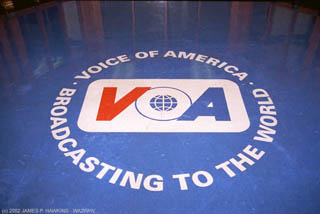 |
U.S. Transmitter Sites |
|
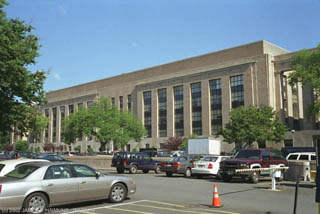 |
| Plaque identifying VOA outside of the building entrance. |
|
| Inner entry door with VOA banner. | |
| Health and human services mural. |
|
Although other types of transmitting antennas are used, the most widely used for short-wave broadcast is the curtain antenna, which sharply focuses the signal in the desired direction. Some of these antennas are built to be mechanically turned on massive rotating poles. The ones used by VOA are directed by adjusting the relative phases of the dipoles in the array. I have also heard these antennas referred to as stacked dipoles. | ||
| These excellent models are displayed behind glass in one of the halls of the VOA building in Washington D.C. The caption under this display reads: "The IBB electronically steerable beam antenna has the capability of directing broadcast signals to different directions." The fine lines of the antenna model are etched on lucite. | |||
| VOA live broadcasts originate from suites, all with the same basic design. A relatively large studio with 5 microphone stations, coupled with a control room with an engineer on the right and producer on the left as they face the studio. In this photo, only the engineer is shown. |
| Radio Studio with 5 microphone stations from front and rear views. Robotically controlled television cameras are also positioned and are manipulated from the control room. |
|
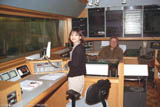 |
Producer and engineer in control room. |
| Another suite, showing the producer on the left in the foreground and the engineer on the right in the background. The producer/director follows a program plan, preparing the engineer and talent for the next switch of activity. Also, the producer makes sure that each program segment starts and ends at precisely the right time. The engineer controls the levels and sources of program input, whether it be from an archive recording, the studio talent or remote sources. |
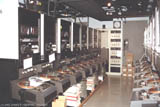 |
Archiving |
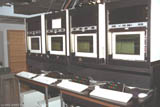 |
Digital program editing |
| Central Recording Tape Duplication |
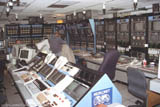 |
Television control room. |
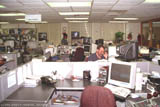 |
Newsroom. |
|
Control Room History and Description by Mike McNea The original Voice of America master control, a well known icon with it's large curved console, was built
by Gates Radio when VOA relocated from New York to Washington in 1954. Using an entire rack room of Langevin tube
amplifiers, 48Vdc telephone crossbar and stepper relays for switching, it was capable of switching 99 inputs to
26 outgoing channels. Leased program circuits carried programming to domestic |
| Original Washington master control circa 1986. The console was built by Gates. |
|
| 1987 Master Control (lights dimmed to show panel lights) |
|
| Same control racks with more lighting. Operator consoles are visible at the end. |
|
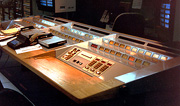 |
Console was designed by the VOA staff and fabricated by an auto body shop. |
| VOA'S current master control room, constructed by Harris Broadcast. MC Technicians Steve Brody (L) and Mike McNea (R). |
|
| Routers for program switching. |
BACK TO "JIM HAWKINS RADIO & BROADCAST TECHNOLOGY PAGE